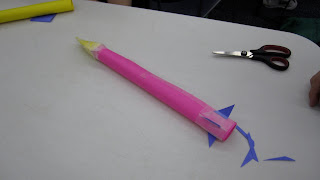Kennedy Space Science Education Center
Observation of 2 groups of elementary (primary) school students was made whilst they were on a field trip to the Space Science Education Center. Students were completing interactive workshops.
In the first workshop students built and tested a stomp rocket. Questioning was used to get students brainstorm prior knowledge of rockets. Students gave answers that the instructor then verbally categorized for them; these included the shape, size and function of rockets, how dangerous rockets were and the types of rockets. Students were then shown a diagram of the forces acting on a rocket and through questioning walked through each of the forces. Students were then asked whether they had any prior knowledge on Newton’s Laws and some did, despite being in year 4! Students were walked through each of Newton’s three laws and taught how they relate to how a rocket works.
Once this introduction was complete students were shown how to construct the first part of their rocket. Thin cardboard was made into a cylinder by wrapping it around a thin piece of PVC piping. Students were then directed to create a cone shape out of a semi-circle piece of cardboard. The size, shape and way they attached the top of their rocket was left up to them. Students were then told to create fins for their rockets out of scrap cardboard, again they were encouraged to consider the concepts discussed and make these any size or shape they felt would make their rocket most successful in launching.
Rockets were launched by placing them on the end of PVC piping and placing an empty 2 litre soft drink bottle at the other end. When the bottle is stomped on air is released through the pipe and into the rocket, causing it to launch. In this instance there was only time and opportunity for students to have a single launch. In school lessons it would be ideal to allow students opportunity to make changes to their rockets and encourage the to discuss what went wrong/right in terms of scientific concepts. Older students could be given the freedom of constructing their rockets out of any material they liked, as long as it launched from the same structure, using the same sized soft drink bottle.
See the following website for more information:
The second activity observed was the construction of a model of the solar system out of beads and string. Students were taught about Astronomical Units and why they are used in space measurements and then these units were used to develop a scale model. Students simply multiplied the AU by 10 to work out how many cm their planets were from the Sun. This was completed as a class group. Students then marked on their screen with a felt tip pen each of the planets (including the asteroid belt) and then added the Sun and the planets one at a time by knotting them onto the string in the correct position. Labels can be added to the model. The activity would also be suitable for older students in Australia, particularly year 6 or year 7. Extension students can be asked to display a scale bar with their model, showing km as well as AU. String needs to be at least 3m in length. Students will need 10 beads of differing colours.
For other great activities on the Solar System and Universe go to:
Each of these activities went for an hour, the second activity would not take any longer than this in a classroom situation. The first activity could definitely be extended to ensure true inquiry-based learning and to support development in understanding of the design process.
Students then explore a variety of mini-hand on activities set up around the education room. Including an activity where they are required to trace the shape of a star by only looking at its mirror image. Rather than drawing onto the star, as I have seen this done in the past, the star is made out of electrical tape and on a metal surface. When students failed to trace the star an alarm was set off through an electrical circuit. I like this interpretation of this activity as it allows the activity to involve electrical circuits and reflection and be based in space science. Astronauts are required to work with mirrors in space. Students were also shown a gyroscope and given the opportunity to use it. A tray was also set up at the end of the room containing sand and pebbles. The tray had water running through it from a tube at one end, the water was then filtered through at the opposite end and re-used. Students are able to experiment with land formations as a result of weathering.
This is a great robotics/rover lesson sequence I found online:







No comments:
Post a Comment